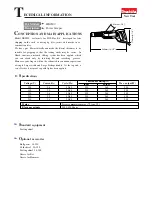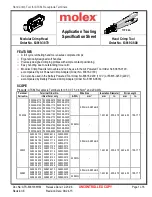
4. MAINTENANcE
4.1.
If the unit is not to be used for a long period, carefully remove suction pipe from the brake fluid container, wipe the pipe clean.
Wipe unit clean with a dampened cloth, before storing it away in a safe, dry, childproof location.
4.2.
Should the unit stop working, first check the internal 1A fuse (fig.1.4) to see if it has blown.
4.3.
there are no regularly servicable parts to the unit, it should be returned to an authorised Sealey agent for repair if needed.
NOTE:
It is our policy to continually improve products and as such we reserve the right to alter data, specifications and component parts without prior notice.
IMPORTANT:
no liability is accepted for incorrect use of this product.
WARRANTY:
Guarantee is 12 months from purchase date, proof of which will be required for any claim.
INFORMATION:
for a copy of our latest catalogue and promotions call us on 01284 757525 and leave your full name and address, including postcode.
Sole uk Distributor, Sealey Group,
Kempson Way, Suffolk Business
Park
,
Bury St. Edmunds, Suffolk,
IP32 7Ar
Original Language Version
VS0206.V2 Issue: 2(I) - 09/08/13
01284 757500
01284 703534
sales@sealey.co.uk
www.sealey.co.uk
W e b
3.2. brake bleeding procedure.
DO NOT touch the vehicle’s brake pedal whilst bleeding the brakes.
refer to the vehicle manufacturer’s instructions for brake bleeding and wheel sequence before proceeding. If no specific instructions from
the vehicle manufacturer exist, follow the instructions detailed below. If the manufacturer has not supplied a specific figure for the
maximum pressure for this operation, it is advised to keep the pressure within the 1.5 to 2Bar range, to avoid damaging the brake
fluid reservoir etc.
fully prepare the vehicle by jacking it up or by using a ramp, remove the wheels from the vehicle as required to gain access, so that
work can commence as soon as the unit is turned on.
3.2.1. remove the cap on the vehicle’s brake fluid reservoir. If the brake fluid level is not at its maximum level, top it up. fit the universal
adaptor to the brake fluid reservoir, tighten it and ensure that there is a good seal.
3.2.2. connect the pressure delivery hose's quick connector to the universal adaptor.
3.2.3. Ensure that the pressure knob on the unit is fully off (anti-clockwise) and switch on the unit. Adjust the pressure to the required setting
by turning the pressure knob clockwise.
3.2.4. Starting with the wheel furthest away from the brake fluid reservoir, connect one end of the tube from the bleed bottle to the brake
nipple and, using a brake spanner, open the nipple approximately ¼ turn (fig.2), brake fluid will flow through the clear pipe into the
bottle, when there are no visible bubbles in the fluid, tighten the bleed nipple and remove the pipe, taking care not to spill any brake fluid.
3.2.5. repeat the procedure at each location in turn, as required.
3.2.6. When finished, turn the unit off. Open the pressure release valve to depressurise the unit, allow the pressure gauge to return to zero.
DO NOT
attempt to remove the adaptor from the vehicle's brake fluid reservoir, until the unit is de-pressurised. close the pressure
release valve and turn the pressure knob fully off (anti-clockwise).
3.2.7. disconnect
the pressure delivery hose from the adaptor by releasing the quick-fit coupling. take care not to spill any brake fluid and
then remove the adaptor from the brake fluid reservoir. check the level of the brake fluid in the reservoir, any excess fluid should be
removed, or top it up if necessary.
3.2.8. refit the vehicle's brake fluid reservoir cap.
3.3. changing the brake fluid.
3.3.1. carry out the brake bleeding procedure as described in 3.2.
3.3.2. Allow a longer period of time when bleeding, to allow the new fluid to flush out the old fluid.
When new fluid can be seen in the clear tube, tighten the brake nipple.
3.3.3. repeat this procedure at each wheel in turn.
3.3.4.
disconnect as above (3.2.6. to 3.2.8.).
NOTE:
When brake bleeding and/or brake fluid changing is complete, test the action of the brake pedal to ensure that the brakes
are working correctly and are not spongy, before taking the vehicle onto the road.
3.4. clutch bleeding procedure.
3.4.1. refer to the relevant vehicle manufacturer’s instructions for clutch bleeding procedure.
If no specific instructions from the vehicle manufacturer exist, the same basic procedures as for brake bleeding can be followed.
dispose of all waste brake fluid responsibly. contact your local authority for details.
Environmental Protection.
recycle unwanted materials instead of disposing of them as waste. All tools, accessories and packaging
should be sorted, taken to a recycle centre and disposed of in a manner which is
compatible
with
the
environment.
WEEE Regulations.
dispose of this product at the end of its working life in compliance with the EU directive on Waste Electrical and
Electronic Equipment. When the product is no longer required, it must be disposed of in an environmentally protective
way. contact your local solid waste authority for recycling information.
Parts support is available for this product. To obtain a parts listing and/or diagram, please log on to
www.sealey.co.uk, email sales@sealey.co.uk or phone 01284 757500.
© Jack Sealey limited





















